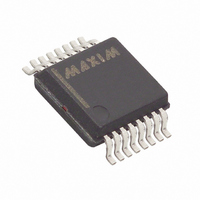MAX1099CEAE+ Maxim Integrated Products, MAX1099CEAE+ Datasheet - Page 18

MAX1099CEAE+
Manufacturer Part Number
MAX1099CEAE+
Description
IC ADC 10BIT SERIAL 16-SSOP
Manufacturer
Maxim Integrated Products
Datasheet
1.MAX1099CEAE.pdf
(20 pages)
Specifications of MAX1099CEAE+
Number Of Bits
10
Sampling Rate (per Second)
900
Data Interface
MICROWIRE™, QSPI™, Serial, SPI™
Number Of Converters
1
Power Dissipation (max)
2.2mW
Voltage Supply Source
Single Supply
Operating Temperature
-40°C ~ 85°C
Mounting Type
Surface Mount
Package / Case
16-SSOP
Full Temp Accuracy
+/- 4 C
Digital Output - Bus Interface
Serial (3-Wire)
Digital Output - Number Of Bits
10 bit
Maximum Operating Temperature
+ 85 C
Minimum Operating Temperature
- 40 C
Output Type
Digital
Lead Free Status / RoHS Status
Lead free / RoHS Compliant
example, the Belden 8451 works well for distances up
to 100 feet in a noisy environment. Connect the shield
to SH0-0H.
Cable resistances affect remote-sensor accuracy; 1Ω
series resistance introduces +0.45°C error.
Temperature measurements will reflect significant error
if a portion of the bias current supplied to the diode
anode is allowed to flow through parallel paths to
ground. If the diode-connected transistor is mounted
on a PC board, suppress error-producing “leakage”
current by surrounding the collector/base leads with a
metal trace that is connected to the SHO shield output
(Figure 8).
For best performance, use PC boards. Do not use wire-
wrap boards. Board layout should ensure that digital
and analog signal lines are separated from each other.
Do not run analog and digital (especially clock) signals
parallel to one another or run digital lines underneath
the ADC package.
High-frequency noise in the V
affect ADC performance. Bypass the supply with a
0.1µF capacitor close to pin V
lead lengths for best supply-noise rejection. If the
power supply is very noisy, connect a 10Ω resistor in
series with the supply to provide lowpass filtering.
10-Bit Serial-Output Temperature Sensors
with 5-Channel ADC
Figure 8. Remote Diode Shielding for PC Boards
18
______________________________________________________________________________________
Layout, Grounding, and Bypassing
SHIELD
Remote Diode Shielding
DD
DD
. Minimize capacitor
CATHODE
power supply may
ANODE
Relative accuracy is the deviation of the values on an
actual transfer function from a straight line. This straight
line can be either a best-straight-line fit or a line drawn
between the endpoints of the transfer function, once
offset and gain errors have been nullified. The static lin-
earity parameters for the MAX1098/MAX1099 are mea-
sured using the best-straight-line fit method.
Differential nonlinearity is the difference between an
actual step width and the ideal value of 1LSB. A DNL
error specification of less than 1LSB guarantees no
missing codes and a monotonic transfer function.
Offset error is the difference between the ideal and the
actual offset points. For an ADC, the offset point is the
midstep value when the digital output is zero.
Gain or full-scale error is the difference between the
ideal and actual gain points on the transfer function,
after the offset error has been canceled out. For an
ADC, the gain point is the midstep value when the digi-
tal output is full scale.
Aperture delay (t
rising edge of the sampling clock and the instant when
an actual sample is taken.
TRANSISTOR COUNT: 13,669
PROCESS: BiCMOS
Differential Nonlinearity (DNL)
AD
) is the time defined between the
Chip Information
Relative Accuracy
Aperture Delay
Definitions
Offset Error
Gain Error












